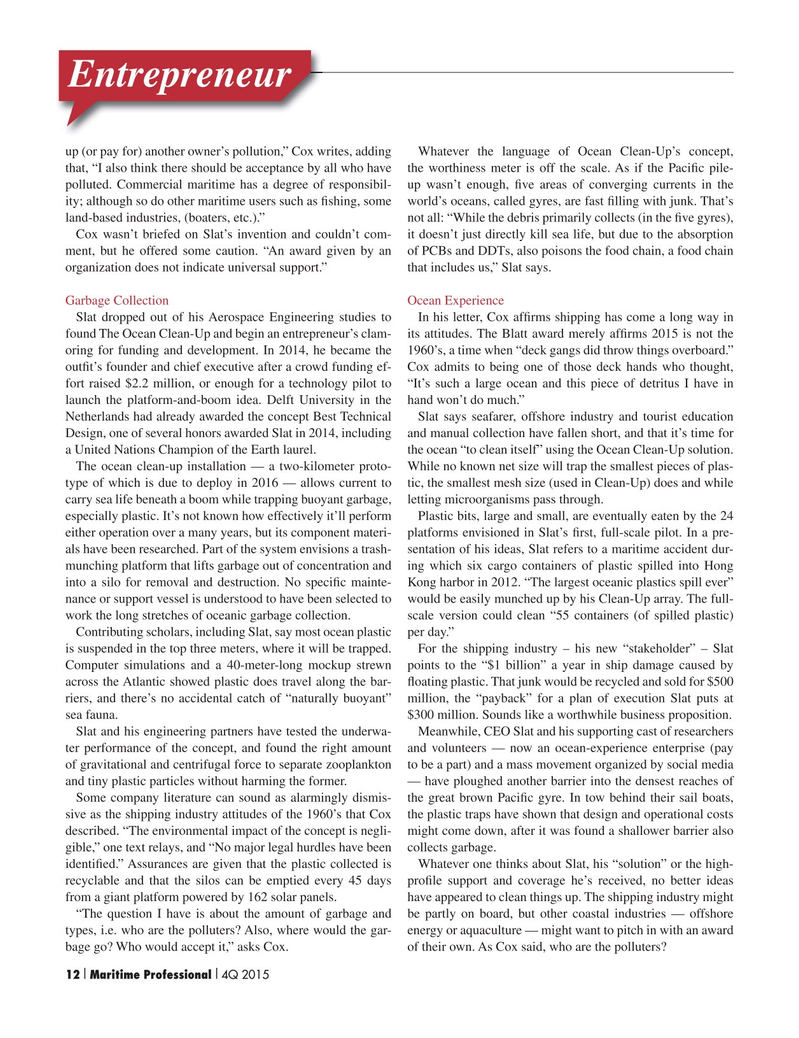
Page 12: of Maritime Logistics Professional Magazine (Q4 2015)
Read this page in Pdf, Flash or Html5 edition of Q4 2015 Maritime Logistics Professional Magazine
Entrepreneur up (or pay for) another owner’s pollution,” Cox writes, adding Whatever the language of Ocean Clean-Up’s concept, that, “I also think there should be acceptance by all who have the worthiness meter is off the scale. As if the Paci? c pile- polluted. Commercial maritime has a degree of responsibil- up wasn’t enough, ? ve areas of converging currents in the ity; although so do other maritime users such as ? shing, some world’s oceans, called gyres, are fast ? lling with junk. That’s land-based industries, (boaters, etc.).” not all: “While the debris primarily collects (in the ? ve gyres),
Cox wasn’t briefed on Slat’s invention and couldn’t com- it doesn’t just directly kill sea life, but due to the absorption ment, but he offered some caution. “An award given by an of PCBs and DDTs, also poisons the food chain, a food chain organization does not indicate universal support.” that includes us,” Slat says.
Garbage Collection Ocean Experience
Slat dropped out of his Aerospace Engineering studies to In his letter, Cox af? rms shipping has come a long way in found The Ocean Clean-Up and begin an entrepreneur’s clam- its attitudes. The Blatt award merely af? rms 2015 is not the oring for funding and development. In 2014, he became the 1960’s, a time when “deck gangs did throw things overboard.” out? t’s founder and chief executive after a crowd funding ef- Cox admits to being one of those deck hands who thought, fort raised $2.2 million, or enough for a technology pilot to “It’s such a large ocean and this piece of detritus I have in launch the platform-and-boom idea. Delft University in the hand won’t do much.”
Netherlands had already awarded the concept Best Technical Slat says seafarer, offshore industry and tourist education
Design, one of several honors awarded Slat in 2014, including and manual collection have fallen short, and that it’s time for a United Nations Champion of the Earth laurel. the ocean “to clean itself” using the Ocean Clean-Up solution.
The ocean clean-up installation — a two-kilometer proto- While no known net size will trap the smallest pieces of plas- type of which is due to deploy in 2016 — allows current to tic, the smallest mesh size (used in Clean-Up) does and while carry sea life beneath a boom while trapping buoyant garbage, letting microorganisms pass through. especially plastic. It’s not known how effectively it’ll perform Plastic bits, large and small, are eventually eaten by the 24 either operation over a many years, but its component materi- platforms envisioned in Slat’s ? rst, full-scale pilot. In a pre- als have been researched. Part of the system envisions a trash- sentation of his ideas, Slat refers to a maritime accident dur- munching platform that lifts garbage out of concentration and ing which six cargo containers of plastic spilled into Hong into a silo for removal and destruction. No speci? c mainte- Kong harbor in 2012. “The largest oceanic plastics spill ever” nance or support vessel is understood to have been selected to would be easily munched up by his Clean-Up array. The full- work the long stretches of oceanic garbage collection. scale version could clean “55 containers (of spilled plastic)
Contributing scholars, including Slat, say most ocean plastic per day.” is suspended in the top three meters, where it will be trapped. For the shipping industry – his new “stakeholder” – Slat
Computer simulations and a 40-meter-long mockup strewn points to the “$1 billion” a year in ship damage caused by across the Atlantic showed plastic does travel along the bar- ? oating plastic. That junk would be recycled and sold for $500 riers, and there’s no accidental catch of “naturally buoyant” million, the “payback” for a plan of execution Slat puts at sea fauna. $300 million. Sounds like a worthwhile business proposition.
Slat and his engineering partners have tested the underwa- Meanwhile, CEO Slat and his supporting cast of researchers ter performance of the concept, and found the right amount and volunteers — now an ocean-experience enterprise (pay of gravitational and centrifugal force to separate zooplankton to be a part) and a mass movement organized by social media and tiny plastic particles without harming the former. — have ploughed another barrier into the densest reaches of
Some company literature can sound as alarmingly dismis- the great brown Paci? c gyre. In tow behind their sail boats, sive as the shipping industry attitudes of the 1960’s that Cox the plastic traps have shown that design and operational costs described. “The environmental impact of the concept is negli- might come down, after it was found a shallower barrier also gible,” one text relays, and “No major legal hurdles have been collects garbage. identi? ed.” Assurances are given that the plastic collected is Whatever one thinks about Slat, his “solution” or the high- recyclable and that the silos can be emptied every 45 days pro? le support and coverage he’s received, no better ideas from a giant platform powered by 162 solar panels. have appeared to clean things up. The shipping industry might “The question I have is about the amount of garbage and be partly on board, but other coastal industries — offshore types, i.e. who are the polluters? Also, where would the gar- energy or aquaculture — might want to pitch in with an award bage go? Who would accept it,” asks Cox. of their own. As Cox said, who are the polluters?
12 Maritime Professional 4Q 2015I I 1-17 Q4 MP2015.indd 12 11/18/2015 10:28:47 AM

 11
11

 13
13
